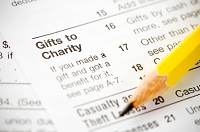The Tax Court recently decided a case in which it denied a charitable deduction of over $27,000 in non-cash contributions. The case, while unfortunate for the taxpayer at issue, is a good opportunity to review the rules around substantiation of charitable donations, and how non-cash contributions must be handled.
Here, the taxpayer made a large donation of personal items—including clothing and furniture—to a 501(c)(3) organization called AMVETS. He previously had received blank receipts signed by the charity, with lines for donor, date and estimated donation value. He filled out the receipt, giving an estimated value of $27,767 broken down between clothing and non-clothing. He arrived at this value by using a Salvation Army website that estimates low and high values for used property. In denying the deduction, however, the court emphasized that the taxpayer had not complied with various requirements for substantiating his contributions. These requirements are broken out below:
Contributions under $250. Generally, for non-cash contributions under $250, taxpayers need to have a receipt from the charity showing its name, the date and location of the contribution, and a description of the property donated. However, the regulations state that a receipt is not needed if the contribution is made in circumstances where getting a receipt isn’t practical (e.g., dropping off goods at a charity’s unattended donation site). However, the taxpayer must still maintain reliable written records with respect to the donated property.
Here, the donor did maintain a spreadsheet showing in detail the type and number of items contributed, and the value assigned to each. However, even if his spreadsheet met the reliable written records requirement, it wouldn’t matter because the size of his donation meant he was subject to the more stringent rules discussed below.
Contributions of $250 or more. A taxpayer can deduct a gift of $250 or more only if he substantiates with a contemporaneous written acknowledgment of the contribution by the charitable organization. This must include a description of the property (other than cash); a statement as to whether the charitable organization provided any goods or services; and if goods or services were provided, a description and good faith estimate of their value. The regulations make clear that separate contributions of less than $250 to the same charity will not be aggregated for purposes of this rule.
Here, because the blank forms had been signed by the charity before receiving the property, the IRS questioned whether they served as a proper acknowledgement from the charity. But at any rate, the receipts didn’t contain a sufficient description of the property donated.
Contributions exceeding $500. In addition to complying with the substantiation rules above for contributions of $250 or more, a contribution over $500 also requires the taxpayer to maintain reliable written records (above and beyond what would be required for contributions under $250) around how the property was acquired, and its cost or other basis. Here, the court pointed out that the taxpayer didn’t have any records around how the items were acquired or what their bases were.
Contributions exceeding $5,000. For contributions of property (other than public traded securities) over $5,000, a taxpayer must satisfy the requirements discussed above and also obtain a qualified appraisal (a summary of which must be attached to the tax return). Here, the taxpayer did neither.
Bottom Line. Many taxpayers make non-cash contributions such as used clothing and household items, and expect to be able to deduct them come tax time. However, failing to meet the requirements discussed above can trip up those plans. Keep in mind that for a series of smaller donations (e.g., each under $250), the contemporaneous acknowledgment from the charity will not be required—but the taxpayer will nonetheless need to keep reliable written records in order to substantiate the deduction. And for larger contributions, taxpayers should be prepared to get the receipt they need from the charity, keep necessary records and get an appraisal if necessary.
For more information on the charitable deduction, check out IRS Publication 526. The name of the case is Thad D. Smith v. Commissioner, TC Memo 2014-203.


